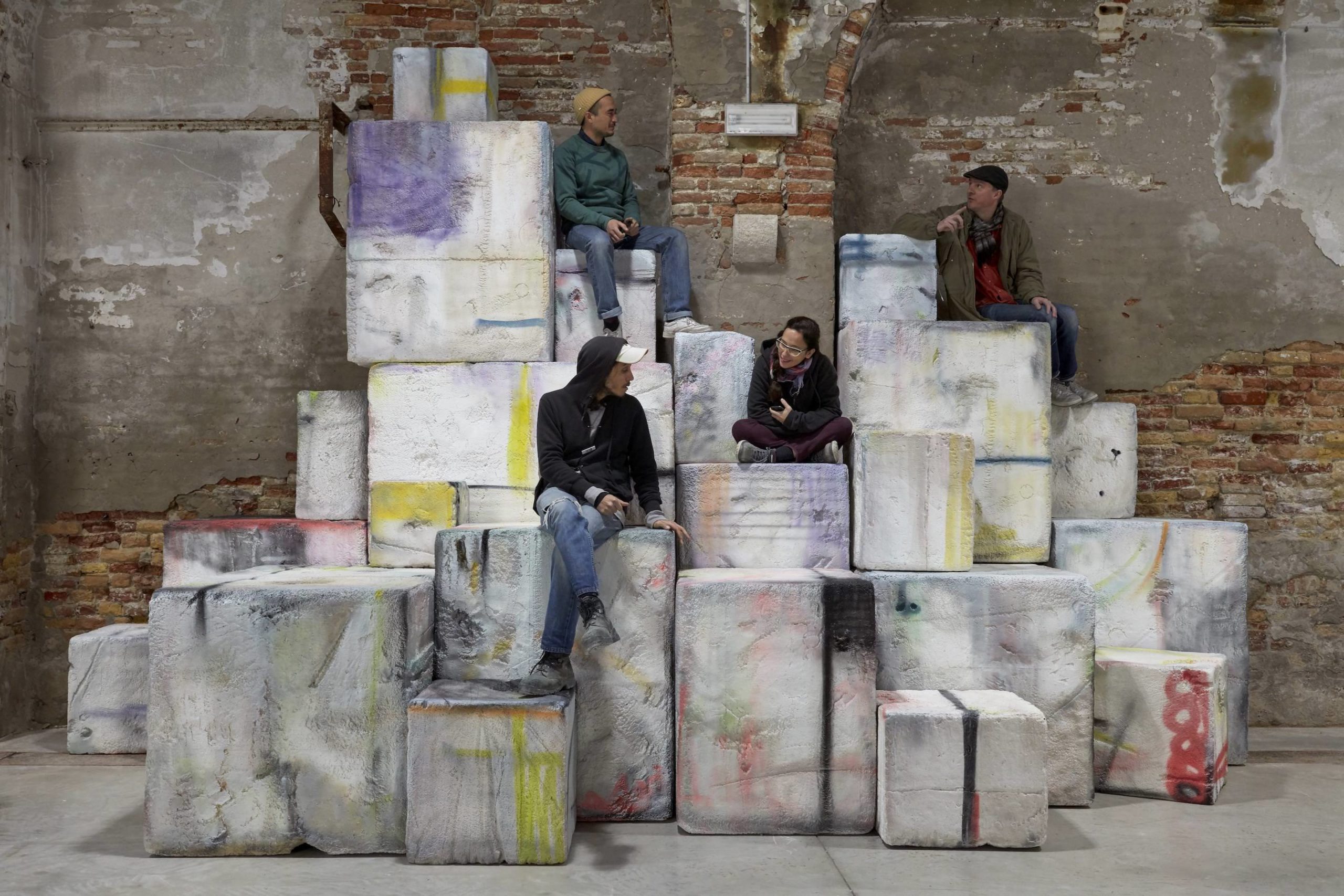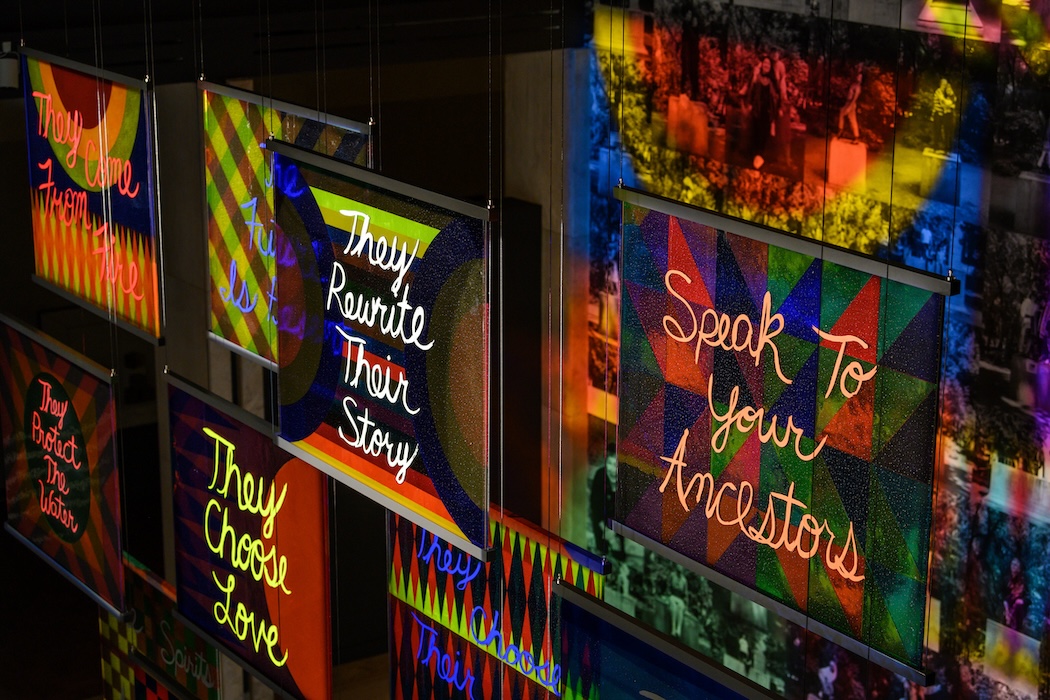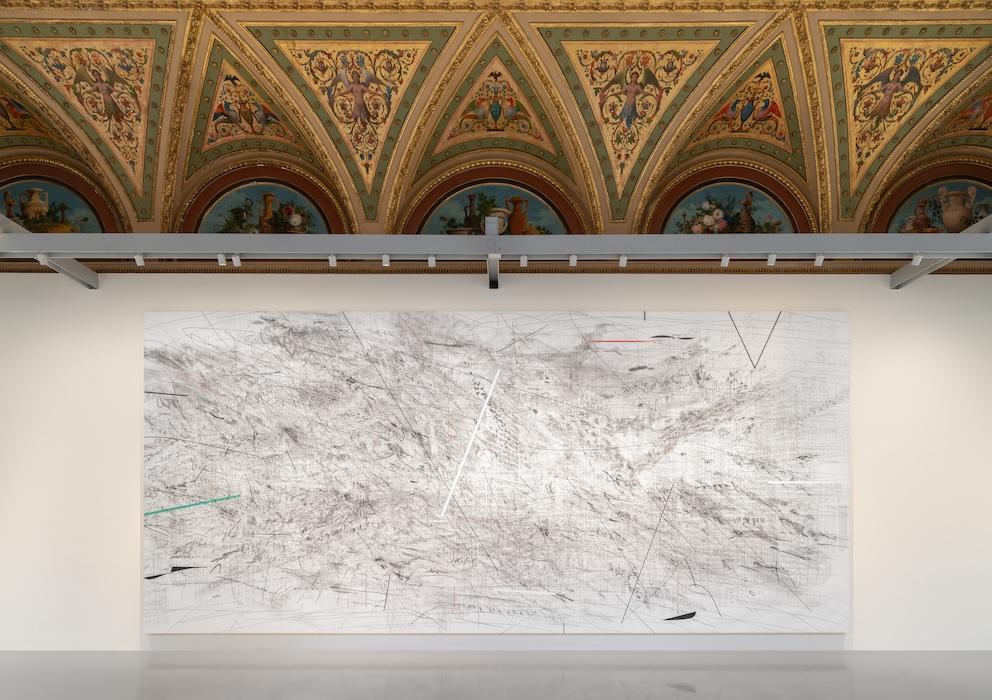Ireland’s 2019 Venice Biennale pavilion is an exploration of sculptural presence that asks for a moment of pause.
In 2009 Eva Rothschild wowed Tate Modern visitors with “Scribble in Space,” a delicate lattice of large triangles whose delicate black lines plunged through the almost 90-yard main gallery. Ten years later, the Irish artist represents her home country at the 58th International Art Exhibition – La Biennale di Venezia with the same sense of monumentalism, just “scruffier.”
“The Shrinking Universe” is an immersive sculptural experience, created by Rothschild and curated by Mary Cremin, that initiates a moment of pause at the end of the main Arsenale building. A colorful yet solemn scene that brings to mind the seaside – not the sandy beaches of vacation luxury, but the rocky industrial docks of truant teens and smoke breaks.
Rothschild asks me to join her on Amphi, the graffitied tower of pockmarked polystyrene blocks, one of four main works in conversation with each other in this space. Six feet in the air, we look down at the meandering audience. the artist allowing herself the occasional sharp inhale when someone almost bumps into the works in pursuit of the perfect picture.
“I prepared myself for the Instagram of it all,” laughs Rothschild. “But it’s so much worse than I imagined.”
Against the serendipitous backdrop of a Venetian canal, we watch boats sail behind Spektor, the towering head-like forms cast from bronze.
In the center of the room Princess, like a sudden fountain jet, draws the eye upward tracing the artist’s hallmark stacked metal triangles. The balance of the structure feels temporary, like the frozen moment before the inevitable collapse insinuated by the waxed fabric crash mats supporting its base.
In front of the entrance Drift, a wall of cast concrete painted with geometric forms, forces an interaction with the viewer by necessitating the audience walk around it. On the backside of Drift, a heap of small black casts, edges the wall bleeding into the domain of Princess. The bottle like forms alludes to wasted consumable materials, while the geological nature of the mass hints at a time long after us.
Suspended in the ruins of the past and future, Rothschild asks the viewer to take the work at face value, while accepting not everything is at it seems.
Rothschild’s “The Shrinking Universe” is open to the public through November 24, 2019.
WHITEWALL: Your sculpture is in conversation with itself and the viewer, did that idea play into how you selected your materials?
EVA ROTHSCHILD: I always think of the materials in relation to each other like what it means to have something on something.
Like with the mats at the base of Princess – the steel sculpture is on these soft gym mats creating a strange plinth for the artwork – we’re used to the body and acting on this ‘mattress’, but here you have the heavy steel sculpture impressing itself on the foam in lieu of the body.
It’s bringing together materials we don’t see used within the sculptural lexicon as well as instances where materials that look the same but aren’t, that excites me.
WW: Though your sculpture has a unique vocabulary, there’s a clear nod to modernism. Do you see yourself as part of this tradition of sculpture?
ER: I’m always interested in the way the generic form wins out in both modernist and ancient sculpture.
What intrigues me about Modernism is the reintroduction of the basic form (which is very present in our current built-environment) and this concept harkens back to the sort of real basic geometry of the ancient world.
WW: How has your work developed to where you are now?
ER: Maybe one of the only good things about getting older, is you build up a language. I call this exhibition “The Shrinking Universe,” but I suppose – in relation to practice over time – it’s like an expanding universe… which is actually the state of play astrophysically in the world.
The expanding practice – that’s the reason I am a sculptor because it doesn’t limit in terms of materials or format. It’s easy to feel like anything can come into the world of sculpture, whatever seems necessary to the work.
WW: What was new for you in this work?
ER: I had been anxious about using fabric because the material is so loaded for female artists. However, the decisions I’ve made in my work lately have opened me up to it. The way I use the fabric is more ‘hard core’ almost the same way I use leather. Also, I don’t feel as afraid of color anymore.
I really wanted to bring more things into the work, incorporating whatever it needed.
WW: The pavilion is interactive – we’re sitting on the work right now – what does that word mean to you?
ER: The way we define ‘interactive’ has become quite narrow; a ‘Pavlovian’ experience where you do something else and something specific happens. That’s not interesting to me. What I am interested in is a type of interaction we don’t seem to discuss anymore – the one between the eye, the body, and the artwork – rather than the fingertip or the scroll.
I really want to do is privilege the visual and corporeal experience. For this reason, I’ve introduced seats to support the viewer, to allow the body further access to the work and also to create an awareness of oneself in relation to the object.
WW: What was the hardest part conceptually?
ER: Conceptually it’s always imagining the work into a space. You take risks in aspects of the making of something as big as this. In the end, I had to commit to something at a high level and hope it all came together!
WW: You expressed apprehension that people wouldn’t engage with your pavilion, can you tell us about that?
ER: I’m trying to subvert the “peek and pass” by putting a big wall in front of the entrance.
There’s an orthodoxy of giving time to screen-based media or any work that unfolds in a narrative way. We’ve become so accustomed to looking for the story that it can be hard to appreciate just objects in a room – but that’s my interest.
I wanted to make the intention of the space clear so there’s no sense that there’s anything else to look for when you enter the room. This is a place to inhabit. I cast these seats, stools, benches, and tables for people to sit on in hopes of creating a moment of pause so you can interact with the objects here.










